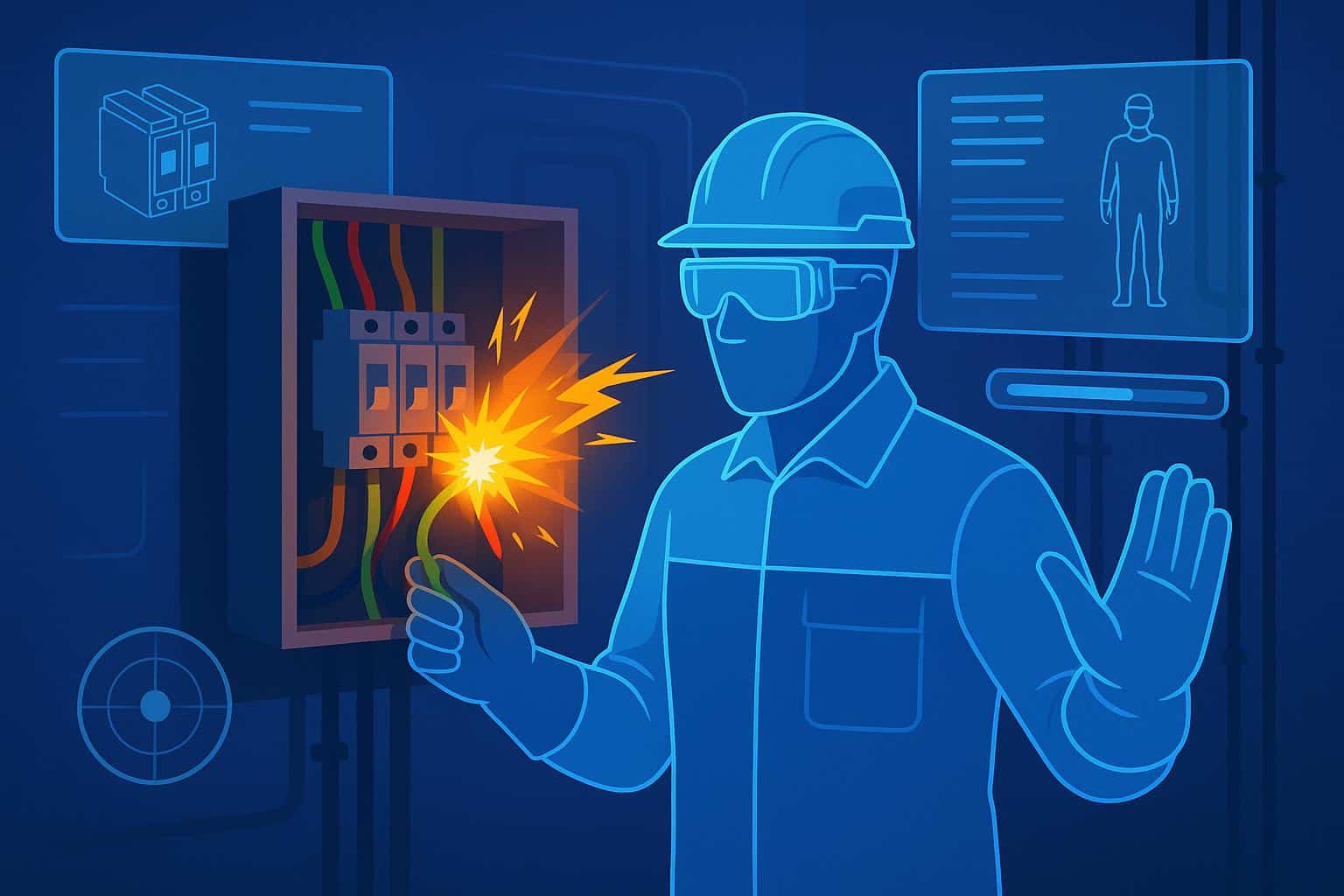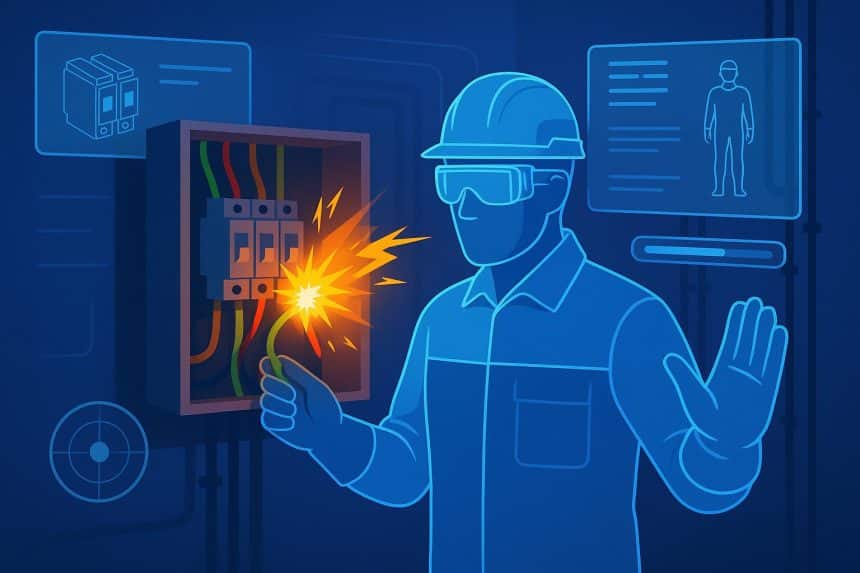Electrical burns are a serious workplace hazard, often leading to long-term injuries, loss of productivity, and significant medical costs. Understanding different types of electrical burns at the workplace is crucial for both employers and employees to prevent accidents. Traditional safety training methods, while effective to a degree, often lack the immersive and interactive elements necessary for employees to fully grasp the dangers of electricity in a real-world setting. This is where augmented reality (AR) training comes into play, offering a transformative solution for enhancing workplace safety.
In this article, we explore how AR technology is revolutionizing employee training, particularly in preventing electrical burns, and why it is becoming a critical component of modern occupational safety programs.

Understanding Electrical Burns in the Workplace
Before diving into AR training, it’s essential to understand the nature of electrical burns. Electrical burns occur when electrical current passes through the body, causing tissue damage, nerve injuries, and in severe cases, organ failure. They differ from thermal burns, as the damage is often internal and may not be immediately visible.
There are several types of electrical burns commonly seen in workplaces:
- Flash Burns: Caused by electrical arcs that produce intense heat and light, damaging the skin without direct contact with electricity.
- Contact Burns: Result from direct contact with energized equipment or wires, leading to localized tissue damage.
- Arc Burns: Occur when electricity jumps from one conductor to another, creating an arc that can cause severe burns.
- Electrical Injuries with Secondary Trauma: These burns are accompanied by falls or other injuries caused by the shock.
Recognizing these types is critical for employees and employers alike. Proper training must address the specific hazards associated with each type of electrical burn to prevent accidents.
Limitations of Traditional Safety Training
Traditional workplace safety training often relies on manuals, videos, and occasional hands-on demonstrations. While informative, these methods have limitations:
- Lack of Realistic Simulation: Workers may not fully understand the intensity of electrical hazards without seeing them in a controlled environment.
- Limited Engagement: Static materials fail to capture attention, leading to lower retention of critical safety procedures.
- Inability to Practice High-Risk Scenarios: Simulating dangerous electrical conditions in real life is risky and often impractical.
Because of these challenges, many employees may not be fully prepared to handle electrical hazards, increasing the likelihood of workplace burns.
How Augmented Reality Enhances Safety Training
Augmented reality overlays digital information onto the real world, creating immersive simulations where employees can interact with virtual objects while remaining safe. When applied to electrical safety training, AR can bridge the gap between theoretical knowledge and practical experience.
1. Immersive Hazard Simulation
AR allows employees to experience realistic electrical hazards without exposure to actual danger. For instance, a worker can interact with a virtual electrical panel, identifying live wires, potential arc flash zones, and unsafe conditions. This hands-on experience enhances understanding and builds muscle memory for real-world scenarios.
2. Interactive Learning Modules
Unlike passive training videos, AR training is interactive. Employees can make decisions in real-time, such as choosing the correct personal protective equipment (PPE) or shutting down electrical circuits safely. Immediate feedback reinforces learning and helps correct mistakes in a controlled environment.
3. Customized Training Experiences
Every workplace has unique electrical risks. AR training programs can be tailored to specific job sites, incorporating realistic layouts, machinery, and electrical configurations. This personalization ensures that employees are prepared for the exact conditions they will encounter.
Benefits of AR Training in Preventing Electrical Burns
Implementing AR in safety training offers numerous advantages over conventional methods, particularly in reducing the incidence of electrical burns.
1. Improved Knowledge Retention
Studies have shown that immersive learning significantly increases retention compared to traditional training. Employees who experience AR simulations are more likely to remember safety protocols and react appropriately during emergencies.
2. Risk-Free Practice
AR allows employees to make mistakes without real-world consequences. Workers can experience electrical arcs, shocks, and burn scenarios virtually, learning to respond correctly without risking injury.
3. Scalability and Accessibility
Once developed, AR training modules can be easily distributed across multiple sites, ensuring consistent safety education for all employees. Remote workers or teams in different locations can access the same immersive training, promoting uniform safety standards.
4. Enhanced Engagement
AR training captivates employees’ attention, making learning more enjoyable and effective. Engaged workers are more likely to internalize safety practices and advocate for safer workplace behaviors.
Integrating AR with Traditional Safety Programs
While AR is a powerful tool, it works best when combined with traditional safety programs. Here’s how organizations can integrate AR effectively:
- Initial Awareness: Begin with classroom sessions to introduce concepts of electrical hazards and different types of electrical burns at the workplace.
- AR Simulation: Use AR to provide hands-on, interactive experiences, reinforcing theoretical knowledge.
- Assessment and Feedback: Implement AR-based assessments to evaluate employees’ understanding and provide real-time feedback.
- Continuous Training: Regularly update AR modules to reflect changes in workplace environments, equipment, and safety standards.
This blended approach ensures comprehensive learning, where employees gain both theoretical knowledge and practical skills to prevent electrical burns.
Real-World Applications of AR in Workplace Safety
Several industries have already begun leveraging AR to prevent electrical accidents:
Manufacturing and Industrial Facilities
AR can simulate complex machinery and electrical systems, helping employees identify potential hazards before they become accidents. Interactive AR manuals guide workers through maintenance procedures safely.
Construction Sites
Construction workers face high risks of electrical burns from exposed wiring and energized equipment. AR training helps them practice identifying and mitigating these risks, reducing accidents and downtime.
Utility and Energy Sectors
Electricians and utility workers encounter high-voltage systems daily. AR simulations allow safe practice of emergency procedures, equipment handling, and protective measures, lowering the likelihood of severe electrical injuries.
Future Prospects of AR in Electrical Safety
The integration of AR in workplace safety is still evolving. Emerging trends indicate exciting possibilities:
- Wearable AR Devices: Smart glasses can provide real-time hazard alerts while employees work, combining training with on-the-job safety reinforcement.
- AI-Driven Simulations: Artificial intelligence can create adaptive training scenarios that adjust difficulty based on the employee’s performance, ensuring optimal learning.
- Integration with IoT: AR systems connected to IoT devices can monitor electrical equipment in real-time, providing predictive safety alerts and minimizing burn risks.
These advancements suggest that AR will not only enhance training but also become an active part of daily workplace safety.
Challenges and Considerations
Despite its benefits, implementing AR training comes with challenges:
- Cost of Technology: Developing AR modules and purchasing devices can require significant investment.
- Technical Skills: Employees and trainers may need additional training to use AR tools effectively.
- Content Accuracy: AR simulations must accurately reflect real-world electrical hazards to ensure safety and compliance with industry standards.
Organizations must carefully plan AR integration, balancing costs, training needs, and safety outcomes.
Conclusion
Workplace electrical burns are preventable with proper education and training. Understanding different types of electrical burns at the workplace is the first step toward reducing injuries. Augmented reality offers a groundbreaking approach to safety training, providing immersive, interactive, and risk-free learning experiences.
By integrating AR with traditional training methods, organizations can ensure employees are better prepared, more engaged, and capable of responding effectively to electrical hazards. As technology continues to evolve, AR will play an increasingly important role in workplace safety, potentially transforming how industries prevent injuries and protect their workforce.
Investing in AR training today is an investment in a safer, more efficient workplace tomorrow—helping companies reduce electrical accidents while enhancing employee confidence and competence.












